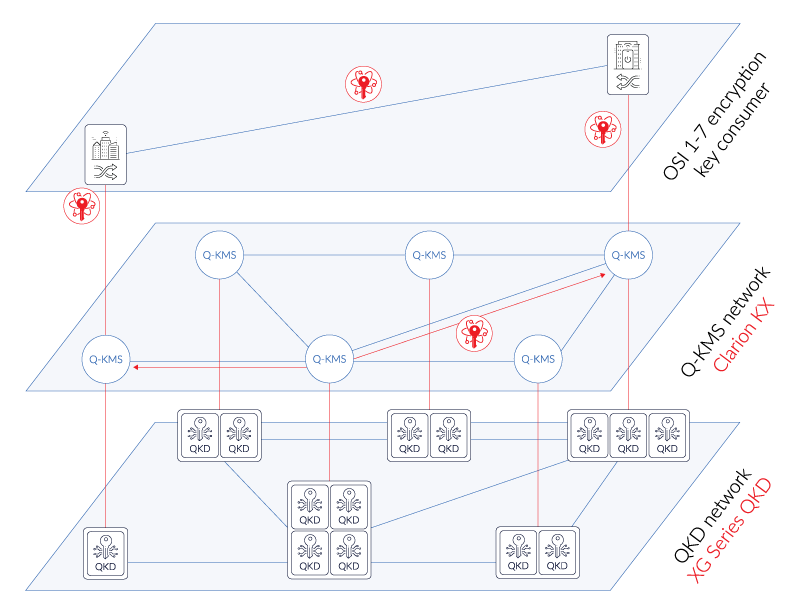This project builds upon the ETSI GS QKD 014 standard, which implements a "trusted node" functionality or, in different words, something more resembling a fully-fledged key management system (KMS).
For a full list, see the ETSI GS QKD 014 standard. It is recommended, that you have prior knowledge of the ETSI GS QKD 014 standard, before trying to use this project.
- SAE: secure application entity
- TN: trusted node
- KME: key management entity
- QKD: quantum key distribution
This project's aim is to transform a regular QKD point-to-point network into a mesh-able network. The trusted node implementation is a layer between the quantum layer and the application layer, working as a middleman.
The trusted node discovers other trusted nodes, KMEs and SAEs and uses the shortest path first algorithm (Dijkstra's algorithm) to route the keys.
Once a path has been established, it calls synchronously the first trusted node, which then calls the next trusted node, etc., in a synchronous fashion.
1st flow:
stateDiagram-v2
SAE_A --> TN_1: /enc_keys
TN_1 --> TN_2
TN_2 --> TN_3
TN_3 --> TN_4: stores the key in the key pool
SAE_A --> SAE_B: key ID notification
2nd flow:
stateDiagram-v2
SAE_A
SAE_B --> TN_4: /dec_keys
TN_4 --> TN_3
TN_3 --> TN_2
TN_2 --> TN_1: removes the key from the key pool
The trusted nodes send and receive keys from the QKD devices, rather than sending them in plain text. However, to later send the 1st key to the 2nd trusted node hop, it takes the 1st and the 2nd key and does an XOR operation on the key. This key is then sent over-the-wire to the trusted node. Then this trusted node then undoes this XOR and gets the 1st key.
In essence, there are 3 main layers of a quantum network:
- Quantum level (physical QKD devices that are in a point-to-point configuration)
- They must implement an ETSI GS QKD 014 API interface in order to interface with this project
- Key management system layer (this project)
- Application layer (actual SAEs that work with this project, not directly with the QKD devices)
Best logical description of this project would be this image from ID Quantique:
This would be the Q-KMS layer.
This project is inspired by, at the moment, in draft stage of ETSI GS QKD 020 standard, but does not fully follow the standard. However, later someone should be able to make this project compatible with the standard, once released.
git clone https://github.com/next-door-key/qkd-trusted-nodecd qkd-trusted-nodepython3 -m venv .venvsource .venv/bin/activatepip install -r requirements.txt./generate-certificates.sh- Configure
docker-compose.ymlto build and start QKD KME simulator docker compose up -dpython3 main.py --reload=True --settings=settings-tn1.json --port=9000
Remember to configure your HTTP clients to use the mutual TLS certificates, otherwise, you'll get a socket hangup message.
The project can be either configured from env variables or better from a settings.json file. There are 4 examples, that are explained below.
{
"id": "tn-1-a2b2",
// The SAE ID that is referenced for the QKD KMEs
"server_cert_file": "certs/tn-1-a2b2.crt",
// These certs and keys will be used to run the HTTPS server
"server_key_file": "certs/tn-1-a2b2.key",
"ca_file": "certs/ca.crt",
// This is the global CA file that all certificates must use
"min_key_size": 64,
// Try to keep these all consistent with the KMEs and other TNs
"max_key_size": 1024,
"default_key_size": 128,
"max_key_count": 50,
"max_keys_per_request": 50,
"attached_kmes": [
// These are meant as those KMEs that are directly linked to this KME.
// If the distance is 0, this means it is locally connected.
// Distance = 1, means on the other side of the QKD device.
// Any more is not recommended, because they will be auto discovered by the TNs themselves.
{
"url": "https://localhost:8030",
"kme_id": "ndk-kme-a2",
"linked_to": "ndk-kme-b2",
// To which other KME is this linked to (point-to-point other end)
"kme_cert": "certs/kme-a2.crt",
// The certificate that will be validated against, to make sure it is the right KME
"sae_cert": "certs/tn-1-a2b2.crt",
// This is the certificate and key to be used, when making requests to the KME
"sae_key": "certs/tn-1-a2b2.key",
"distance": 1
// See above explanation, 0 = is local, 1 = is 1 hop away
},
{
"url": "https://localhost:8040",
"kme_id": "ndk-kme-b2",
"linked_to": "ndk-kme-a2",
"kme_cert": "certs/kme-b2.crt",
"sae_cert": "certs/tn-1-a2b2.crt",
"sae_key": "certs/tn-1-a2b2.key",
"distance": 0
}
],
"attached_saes": [
// These are the SAEs that connect to our trusted node and interact with the QKD 014 REST API
{
"sae_id": "sae-a",
"sae_cert": "certs/sae-a.crt"
// Certificate to validate against
}
],
"attached_trusted_nodes": [
// These are the trusted nodes that are "directly" linked to this trusted node.
// For a better understanding, see the example configuration chapter.
{
"url": "https://localhost:9010",
"id": "tn-2-a2b1",
"cert": "certs/tn-1-a2b2.crt",
// The certificate and key to use, when making the requests
"key": "certs/tn-1-a2b2.key"
}
]
}The project is configurable via settings.json files and are configured to interact with a Docker network of simulated QKD devices (see the QKD simulator project).
In total, there are 3 SAEs, 4 trusted nodes and 3 QKD links (3*2=6 QKD devices). See the below diagram for a topology overview.
- SAE A --> TN 1:
/api/v1/keys/sae-b/enc_keys - TN 1 --> KME B2:
/api/v1/keys/tn-2-a2b2/enc_keys - TN 1 --> TN 2:
/api/v1/kmapi/v1/ext_keys - TN 2 --> KME A2:
/api/v1/keys/tn-1-a2b2/dec_keys - <cycle then repeats with TN 2 moving to the next chain of KMEs and TNs>
It is possible to make this project more secure, but the intended goal of this project, more as a proof-of-concept, was not to create a production-ready system.
The authors take no responsibility of the completeness of the security mechanisms developed in the project.
However, if you would like to get in touch about any security issues, please e-mail security@garkaklis.com, instead of using the issue tracker.
This project originally has been developed for LatQN (Latvian National Quantum Network) project in association with LVRTC (Latvian State Radio and Television Center).
The project is licenced under the GNU Affero General Public Licence Version 3.



